10 years of uninterrupted mobile measurement data from Mars
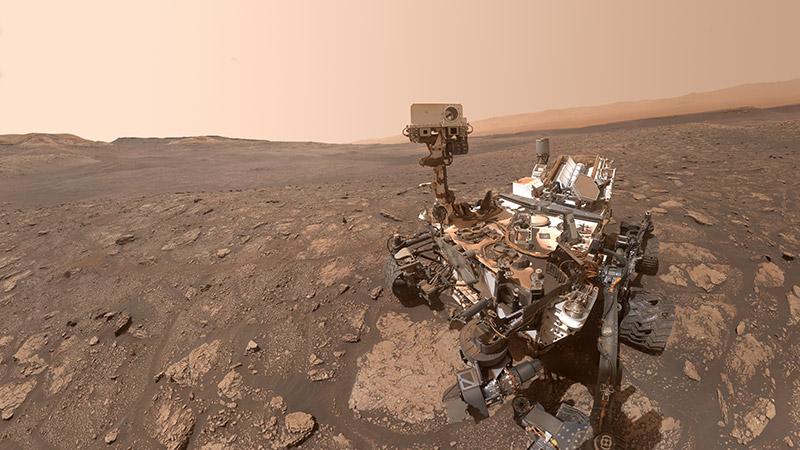
NASA’s Mars Science Laboratory (MSL) ‘Curiosity’ rover first landed on the planet Mars in August 2012. Since that time, the rover has collected a continuous set of environmental measurements that have surprised and delighted the mission’s scientists. Over the last ten years, Curiosity has driven nearly 29 kilometres and ascended 625 meters as it explores its landing site the Gale Crater and the foothills of Mount Sharp. To this day, dramatically surpassing the mission’s initial 2 years objective, the rover’s measurement instruments remain fully operational. Some of the mechanical parts are showing signs of wear, but the sensors are still going strong, delivering unique data from the Red Planet.
In the following article, Lead Engineer from Vaisala’s Sensor Development team Harri Heinonen and Prof. Ari-Matti Harri, Head of Space Observation & Research at the Finnish Meteorological Institute (FMI), discuss why the data from MSL Curiosity is so important.
Background
Vaisala has a long history in helping with space exploration, dating all the way back to the 1950s, when Vaisala converted the frequency of a radio theodolite to help track Sputnik I, the world's first artificial satellite. Since 1992, Vaisala's carbon dioxide, humidity, and temperature sensors have been used in life science experiments both onboard space shuttle flights and at the International Space Station. FMI was responsible for building the humidity and pressure measurement instruments that were deployed on the MSL Curiosity Rover’s Environmental Measurements System (REMS). These sensors utilized Vaisala’s sensor heads, but the relationship between FMI and Vaisala stretches back further than the Curiosity project - Vaisala was founded in 1936 by Professor Vilho Väisälä who also retained senior positions at FMI until 1948. Vaisala and FMI have since worked together on numerous other projects, including interplanetary research missions, such as the Cassini Huygens probe which, in 2005, landed on Titan, Saturn’s largest moon, and the Phoenix lander which successfully landed on Mars in 2008.

Why Mars?
Mars is dusty and cold, with a very thin atmosphere. The average temperature on Mars is about −60 °C. However, daytime air temperatures of +35 °C have been recorded and surface temperatures often rise to +20 °C at midday on the equator, with a low of about −153 °C at the poles.
Known as the ‘Red Planet’ its surface contains large quantities of iron oxide, but the formation of this material is still the subject of debate. Mars has the highest mountain in our solar system (17 miles high – 3 times the height of Mount Everest) and the deepest, longest valley. With the benefit of numerous explorations, there is strong evidence that billions of years ago, Mars was wetter and warmer, with a thicker atmosphere. At that time, it was similar to Earth in many respects and the two are frequently referred to as sister planets. Roughly similar in size and rotating with a similar tilt, the two planets experience similar seasons, with day and night lasting for about 24 ½ Earth hours on Mars. However, the Martian year is almost twice as long (687 Earth days) because it is further from the sun so it has a longer orbit, and is travelling slightly slower.
From a research perspective Mars offers an opportunity to better understand the ways in which Earth has evolved, and how it is likely to change in the future. For example, if Mars and Earth were both wet and warm a few billion years ago, we need to understand why they subsequently took different paths.
After Earth, Mars is the most monitored planet, and given the similarities between the two planets, the data that has been captured to-date has enabled scientists to apply existing Earthly meteorological models to the Martian environment. Ongoing Mars monitoring allows these models to be further refined so that Mars climate predictions are more accurate.
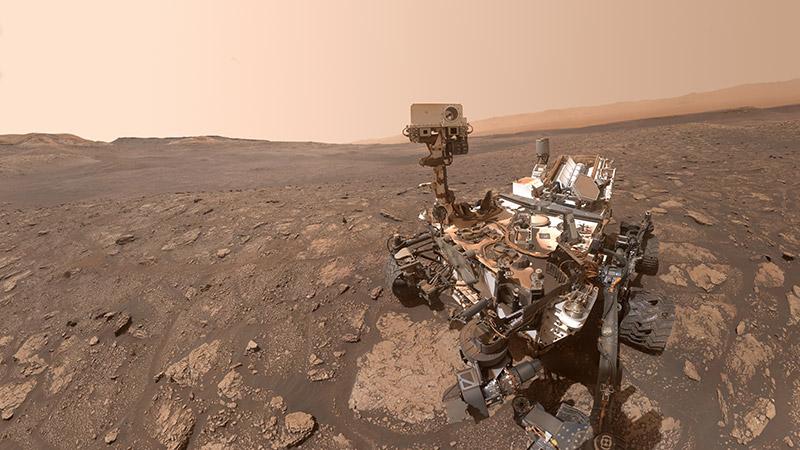
Curious path
Initially, the mission objective for MSL Curiosity was to take environmental measurements for one Martian year. This research was designed to determine whether Mars could have been capable of supporting microscopic life at some stage in its past. The conclusion was a resounding YES.
MSL Curiosity has been performing so well, that NASA recently announced a three-year extension to its mission. During this upcoming period, MSL Curiosity will climb to higher elevations, exploring the critical sulphate-bearing layers that give unique insights into the history of water on Mars.
MSL Curiosity: Selfie from Mars! NASA's Curiosity Mars rover took this portrait in 2020. Even if some of the rover’s wheels and mechanical parts are showing signs of wear, the measurement sensors are still gathering data. Image credit: NASA/JPL-Caltech/MSSS
In addition to cameras and radiation detectors, MSL Curiosity also features instrumentation which is able to conduct chemical analysis on Mars. An Alpha Particle X-Ray Spectrometer measures the amounts and types of chemical elements, when situated close to a rock or soil surface. A ‘ChemCam' laser, camera and spectrograph work together to identify the chemical and mineral composition of rocks and soils. A chemical and mineralogy instrument performs chemical analysis of powdered rock samples, and a sample analysis tool contains three different instruments that search for and measure organic chemicals and light elements that are potentially associated with life. The chemical analysis of rocks and dust is helping scientists better understand the history of Mars. However, environmental measurements tell us about the current conditions on the planet.
Located in the ‘neck’ of the rover, about 1.5m above ground, the MSL Curiosity REMS contains the Vaisala/FMI pressure and humidity sensors as well as sensors for the measurement of temperature, wind and UV radiation. REMS was designed to operate on extremely low power and to operate in a -130 °C to +70 °C temperature range. Measurements are taken for at least 5 minutes every hour, on every Martian day or ‘sol’. This data enables the mission scientists on Earth to provide daily and seasonal reports on meteorological conditions around the rover.
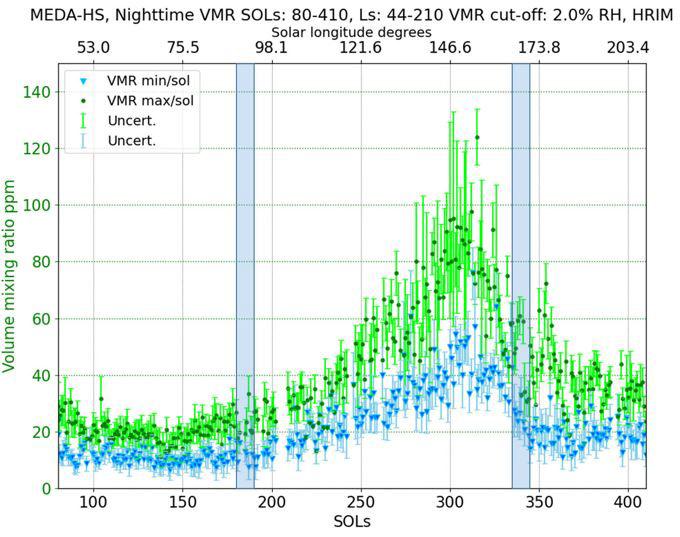
Image: Humidity measurements from Mars
Observations of atmospheric moisture on Mars by the Perseverance Rover during the first 410 Martian days, starting on day 50. In blue, the atmospheric moisture mixing ratio in the early morning before sunrise, when absolute humidity is at a minimum. In green, the mixing ratio around 10 pm in the evening. The observations show that water is adsorbed from the atmosphere to the surface of Mars during the night. During the day, it is released back into the atmosphere. The Curiosity Rover has been delivering similar data from Mars for a decade already.
Image credit: FMI
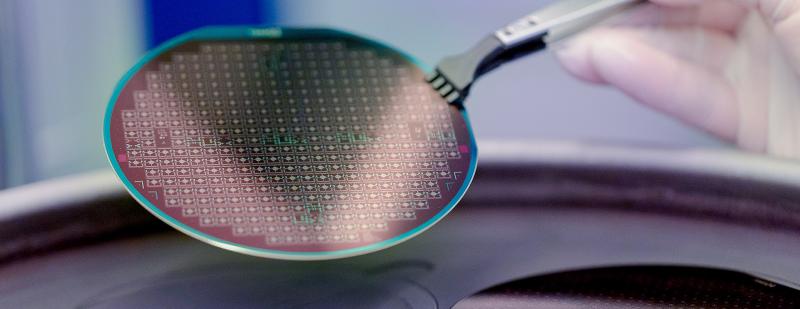
Space-proof sensors
It is difficult to imagine more challenging conditions than those experienced by the sensors onboard NASA’s rovers, both during the flight and whilst exploring the planet’s surface. In addition to enormous variations in temperature and pressure, the sensors must also be capable of tolerating very high levels of vibration.
The Vaisala sensor heads deployed on the Curiosity rover are essentially the same as those that are in everyday use in almost every industry on Earth, although Vaisala made a slight modification to the pressure sensor in order to accommodate the very low ranges that are experienced on Mars. The technologies in both the pressure and humidity sensors were transformational when they were first launched, offering new levels of accuracy and long-term reliability. This is obviously advantageous for Earthly users, but when the nearest service engineer can be 400 million kilometres away, it’s essential!
At FMI, the process to develop the measurement instruments involved the design of electronics, Faraday caging, encapsulation, casings and connectors, as well as dust protection. Naturally, the sensors were tested in every conceivable way before the final design was adopted and the transducers were carefully shipped to the REMS Principal Investigator at the Center for Astrobiology in Spain.
The humidity sensors feature Vaisala’s HUMICAP® technology; a capacitive thin-film polymer sensor consisting of a substrate on which a film of polymer is deposited between two electrodes. The polymer either absorbs or releases water vapour as the humidity of the environment rises or falls, which changes its dielectric properties, and thereby the capacitance of the sensor, which is measured and converted to a humidity reading.
Utilizing a single-crystal silicon material, Vaisala’s BAROCAP® is a micromechanical pressure sensor that measures dimensional changes in its silicon membrane. As the surrounding pressure increases or decreases, the membrane bends, thereby increasing or decreasing the height of the vacuum gap inside the sensor. Opposite sides of the gap act as electrodes, and as the distance between them alters, the sensor capacitance changes, which is measured and converted to pressure readings.
The key feature of both sensors is their long-term stability, and their ability to tolerate dust, chemicals and harsh conditions. The ten-year performance of the sensors onboard MSL Curiosity comes as no surprise to the Vaisala sensor development team, who believe that, as the rover’s REMS gets older, the associated electronics are more likely to fail than the sensor heads themselves.
Vaisala’s determination to constantly innovate and develop world-leading measurement technologies is underpinned by ongoing investment in product development and scientific research. Driven by scientific curiosity and supported by inhouse expertise and experience, it is no coincidence that Vaisala’s sensor performance is literally out of this world.
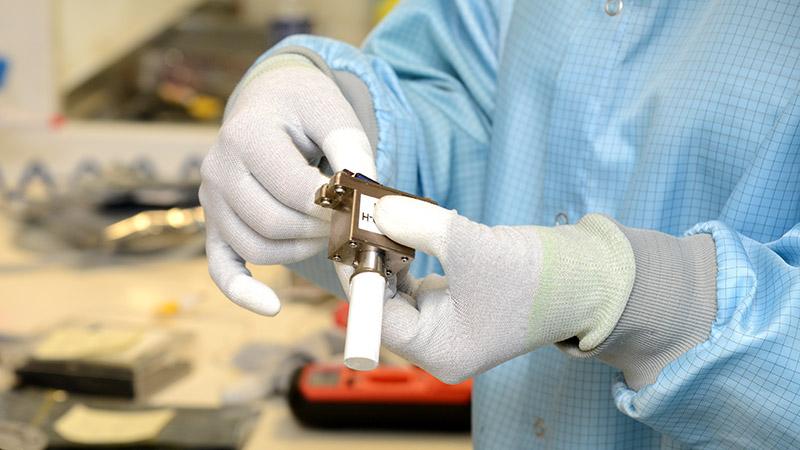
Image: Finnish Meteorological Institute (FMI) designed the humidity and pressure measurement instruments for NASA’s Curiosity and Perseverance Mars rovers. The instruments are based on Vaisala’s sensor technology that is in everyday use in almost every industry on Earth.
Image credit: Tero Pajukallio, Copyright FMI
Finding answers to fundamental questions
The benefits of space research mean different things to different people. For example, on a purely scientific basis, we humans are naturally inquisitive, and want to know more about our world, and beyond. However, this knowledge serves a greater purpose than merely satisfying curiosity; it helps to protect the human race and the environment on which we depend.
If we are able to understand the ways in which planets are formed and evolve, we will be better able to predict and mitigate space phenomena such as planetary destruction, collision with asteroids, mass extinction or conditions making the Earth uninhabitable. Space research helps us to better understand these issues, and for some, Mars research may ultimately enable the inter-planetary transfer of people – if necessary.
According to NASA:
“Space exploration helps to address fundamental questions about our place in the Universe and the history of our solar system. Through addressing the challenges related to human space exploration we expand technology, create new industries, and help to foster a peaceful connection with other nations.”
Mars is the most monitored planet – as the Earth’s sister it provides an opportunity for comparative planetology. Around the world, hundreds of scientific papers have been published on this research, and, given the many shared characteristics of the two planets, many regard Mars as a kind of scientific sand box. For example, if scientists are able to discover why Mars and Earth developed in such different ways, it is hoped that this will lead to a better understanding of Earth’s future.
After discovering that conditions on Mars could have been favourable to life in the past, scientists will investigate whether microscopic life existed at that time, and this may lead to a better understanding of how living organisms first existed, on Earth.
Since 1960, there have been 49 missions to Mars, around half of which have failed. Most of the failures occurred in the earlier years, but these experiences have informed subsequent missions as scientists around the world have learned more about space travel, technology and the complications associated with travelling to, orbiting and landing on Mars.
Looking forward
Environmental monitoring data is necessary for the understanding of a planet’s climate, so the longevity of MSL Curiosity’s performance has been a major bonus, and the reliability of the rover’s onboard instrumentation has meant that considerable extensions to its mission have been made possible.
It is important to appreciate that the MSL Curiosity mission is a vital step in NASA’s Mars Exploration Program. The Perseverance Rover, featuring next generation Vaisala technology in instruments developed by FMI, landed on Mars in February 2021; looking for signs of ancient life and collecting samples of rock and soil for possible return to Earth. Furthermore, operating about 2,000 km apart, the two rovers are laying the foundations for an atmospheric observation network, which is needed to better understand and predict the Martian weather.
Our thorough understanding of the Mars climate and its history requires a better spatial distribution of measurements. So, in the future, it will be important to be able to conduct monitoring at multiple locations on the planet simultaneously.
The data provided by the measurement instruments onboard MSL Curiosity and Perseverance rovers may make it possible to send humans to Mars one day. However, perhaps the greatest value of the measurement data will be to help find answers to humankind’s big questions: How did life begin? Are we alone? and What is the universe made of?
About the authors:
Ari-Matti Harri is heading the Space and Observational Technologies research at the Finnish Meteorological Institute (FMI).
Harri Heinonen is the Lead Engineer of the sensor development at Vaisala.